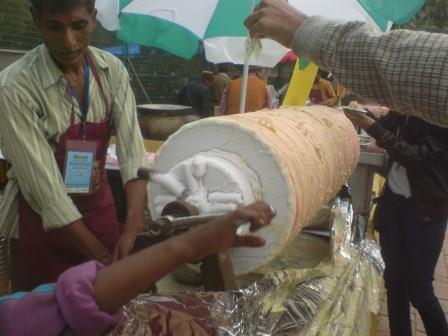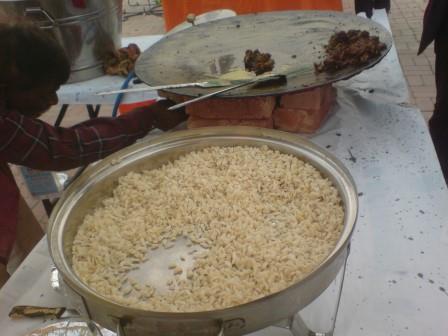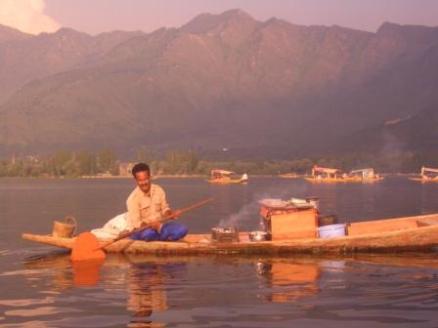Do you want to unwind a busy day with piping hot crab curry with steamed rice in a chilly winter evening in Delhi without leaving a hole in your pocket? If you like to savour street food and looking for some delectable items from across India head to National Association of Street Vendors of India’s (NASVI) Street Food Festival which has opened yesterday in Jawaharlal Nehru Stadium Premises.
NASVI has been championing the rights of street food vendors and has been instrumental in campaigning for the Vendors (Protection of Livelihood and Regulation of Street Vending) Bill, 2012 which was recently passed in parliament. (http://www.thehindu.com/news/cities/Delhi/a-historic-day-for-street-vendors/article5103508.ece) NASVI has been instrumental in bringing to the capital’s food lovers street food across India for the second consecutive year. The street food festival has brought together street foods from Kerala, Tamil Nadu, Andhra Pradesh, Madhya Pradesh, Bihar, Orissa, West Bengal, Punjab and Rajasthan for a three day extravaganza – a treat to city’s food lovers.
Last afternoon J, C, M and I trekked down to the street food festival. We started our food trail with ghee pulao and chicken curry from the Kerala stall. The long grains of rice coated with ghee and the tender succulent chicken cooked neatly wrapped with spices to beat off Delhi chill was a perfect start to the street food trail. The creamy raita (beaten and seasoned yoghurt) with a mix of onion, cucumber and green chillies blended well with the ghee soaked rice and spicy chicken. And all for RS 100/-A perfect start for the hungry souls!
Our next stop was Moong Dal Chilha with a filling of spicy potato and paneer (Rs 50). Personally I am not a paneer fan but the Moong Dal wrap seemed like the perfect snack, lunch item.
Served with mint and coriander chutney and tangy sauce this truly took me by surprise. I strongly recommend you to try this!
We thought of taking a break and stopped by to see a roller ice-cream machine at work. Though the texture of the ice-cream was nice, the rose essence put me off. If you like rose essence and want some fresh ice-cream (Rs 50) being churned out you can give it a try.
Then we headed to the award winning team of Chicken 65 to spice up our taste buds. If you are a fan of fried chicken with no frills, you are bound to fall in love with this layered dish of crispness at the first bite, juicy spices at the second and then it melts into your mouth. Chicken 65 is a perfect accompaniment with a steaming cup of chai or “spirits” as well. So if you are planning to throw a pre-Christmas party tomorrow, pack some Chicken 65 from this stall or pack yourself a treat to unwind a weekend evening.
Next stop was Litti- Mutton. To my mind, NASVI’s street food festival has brought out the best of Bihar’s street food to the capital’s food lovers.
This time, street food festival has three stalls from Bihar, one serving Litti- Mutton and Litti- Chokha and the second serving Litti –Chicken and Litti-Chokha. We treated ourselves into piping hot littis with dollops of ghee from both these stalls. And even got it packed. If you are a garlic fan try Litti Mutton. The mutton curry has a fainting fragrance of mustard cooked with whole garlic soft with the spices … it leaves you yearning for more. Must Try !
The sattu mix of the Litti –Mutton was a little bland compared to Litti-Chokha we had from the stall serving Litti- Chicken. The mix had the perfect blend of mustard oil and pickles. My mouth waters as I recall the taste… Pack yourself a box of Litti – Chokha if you are full with Litti- Mutton. After our litti trail we decided to take a break.
We thought of taking a break and headed for our evening chai ( tea). After a chai– break we headed for Chura with Taas Kebab from Motihari ( East Champaran) which reminded me of buff kebab, spiced chana served with chura in streets of Kathmandu.
The tender, soft pieces of chicken kebab served with crisp chura brought me back memories of my lunch on Kathmandu streets and unveil a completely different side of Bihari street food. I don’t recall tasting Chura with Taas Kebab in last year’s food festival so this was a welcome surprise.
Finally we waited for half an hour chatting away to wait for our friends from Odisha to dish out a crab curry and rice (Rs 180). If you are self-proclaimed crab lover you have to use your hands to scoop out the crab meat from the claws which carried a faint heat of the spices in the light gravy. Though the seasoning could have been a little better, we loved it…
I was a little disappointed with my home turf – West Bengal which is known for its street food starting from rolls, chop to rice meals. The West Bengal stall had varieties of fish and rice. I wish winter varieties of ghugni and peas kachori with alur dom was there. For sweet lovers there is a stall fom West Bengal serving date palm jaggery sweets and Assam stall serving pithas.
Other than these, there there is a grand spread from Maharastra, Bhopal, Tamil Nadu which we failed to explore. Starting from Makki Roti to mirchi pakora, there are ample choices for lunch, evening snack or dinner. So beat the winter chill with street food festival.
Till then happy eating !
Photo : Jyoti Gupta
Important tips
How to reach : Nearest Metro Station – JLN Stadium on Violet Line ( Central Secretariat-Badarpur). Get out from Gate No.3 (Exit) and JLN stadium is round the corner.
Entry Fee: Rs 30. You can even buy coupons online else from the ticket counters at the entrance of JLN stadium.
Payment by coupons: Stock yourself with cash as they do not accept cards. There are lots of coupon counters so buy coupons when you need them.
Date : 20-22 December 2013
Check NASVI’s fb page https://www.facebook.com/Nasviindia?fref=ts.
©itiriti




















